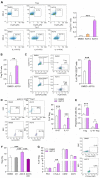Development of FluoAHRL: A Novel Synthetic Fluorescent Compound That Activates AHR and Potentiates Anti-Inflammatory T Regulatory Cells
- PMID: 38998940
- PMCID: PMC11243367
- DOI: 10.3390/molecules29132988
Development of FluoAHRL: A Novel Synthetic Fluorescent Compound That Activates AHR and Potentiates Anti-Inflammatory T Regulatory Cells
Abstract
Aryl Hydrocarbon Receptor (AHR) ligands, upon binding, induce distinct gene expression profiles orchestrated by the AHR, leading to a spectrum of pro- or anti-inflammatory effects. In this study, we designed, synthesized and evaluated three indole-containing potential AHR ligands (FluoAHRL: AGT-4, AGT-5 and AGT-6). All synthesized compounds were shown to emit fluorescence in the near-infrared. Their AHR agonist activity was first predicted using in silico docking studies, and then confirmed using AHR luciferase reporter cell lines. FluoAHRLs were tested in vitro using mouse peritoneal macrophages and T lymphocytes to assess their immunomodulatory properties. We then focused on AGT-5, as it illustrated the predominant anti-inflammatory effects. Notably, AGT-5 demonstrated the ability to foster anti-inflammatory regulatory T cells (Treg) while suppressing pro-inflammatory T helper (Th)17 cells in vitro. AGT-5 actively induced Treg differentiation from naïve CD4+ cells, and promoted Treg proliferation, cytotoxic T-lymphocyte-associated antigen 4 (CTLA-4) expression and interleukin-10 (IL-10) production. The increase in IL-10 correlated with an upregulation of Signal Transducer and Activator of Transcription 3 (STAT3) expression. Importantly, the Treg-inducing effect of AGT-5 was also observed in human tonsil cells in vitro. AGT-5 showed no toxicity when applied to zebrafish embryos and was therefore considered safe for animal studies. Following oral administration to C57BL/6 mice, AGT-5 significantly upregulated Treg while downregulating pro-inflammatory Th1 cells in the mesenteric lymph nodes. Due to its fluorescent properties, AGT-5 could be visualized both in vitro (during uptake by macrophages) and ex vivo (within the lamina propria of the small intestine). These findings make AGT-5 a promising candidate for further exploration in the treatment of inflammatory and autoimmune diseases.
Keywords: Aryl Hydrocarbon Receptor (AHR); CYP1A1; T regulatory cell (Treg); inflammation.
Conflict of interest statement
The authors declare no conflicts of interest.
Figures









Similar articles
-
Novel AHR ligand AGT-5 ameliorates type 1 diabetes in mice through regulatory cell activation in the early phase of the disease.Front Immunol. 2024 Sep 6;15:1454156. doi: 10.3389/fimmu.2024.1454156. eCollection 2024. Front Immunol. 2024. PMID: 39308860 Free PMC article.
-
Norisoboldine, an isoquinoline alkaloid, acts as an aryl hydrocarbon receptor ligand to induce intestinal Treg cells and thereby attenuate arthritis.Int J Biochem Cell Biol. 2016 Jun;75:63-73. doi: 10.1016/j.biocel.2016.03.014. Epub 2016 Mar 28. Int J Biochem Cell Biol. 2016. PMID: 27032495
-
Indole-3-Pyruvic Acid, an Aryl Hydrocarbon Receptor Activator, Suppresses Experimental Colitis in Mice.J Immunol. 2018 Dec 15;201(12):3683-3693. doi: 10.4049/jimmunol.1701734. Epub 2018 Nov 14. J Immunol. 2018. PMID: 30429284
-
Norisoboldine, a natural AhR agonist, promotes Treg differentiation and attenuates colitis via targeting glycolysis and subsequent NAD+/SIRT1/SUV39H1/H3K9me3 signaling pathway.Cell Death Dis. 2018 Feb 15;9(3):258. doi: 10.1038/s41419-018-0297-3. Cell Death Dis. 2018. PMID: 29449535 Free PMC article.
-
Indole scaffolds as a promising class of the aryl hydrocarbon receptor ligands.Eur J Med Chem. 2021 Apr 5;215:113231. doi: 10.1016/j.ejmech.2021.113231. Epub 2021 Feb 4. Eur J Med Chem. 2021. PMID: 33582577 Review.
Cited by
-
Novel AHR ligand AGT-5 ameliorates type 1 diabetes in mice through regulatory cell activation in the early phase of the disease.Front Immunol. 2024 Sep 6;15:1454156. doi: 10.3389/fimmu.2024.1454156. eCollection 2024. Front Immunol. 2024. PMID: 39308860 Free PMC article.
References
MeSH terms
Substances
Grants and funding
LinkOut - more resources
Full Text Sources
Medical
Research Materials
Miscellaneous

